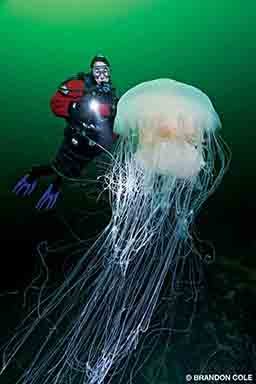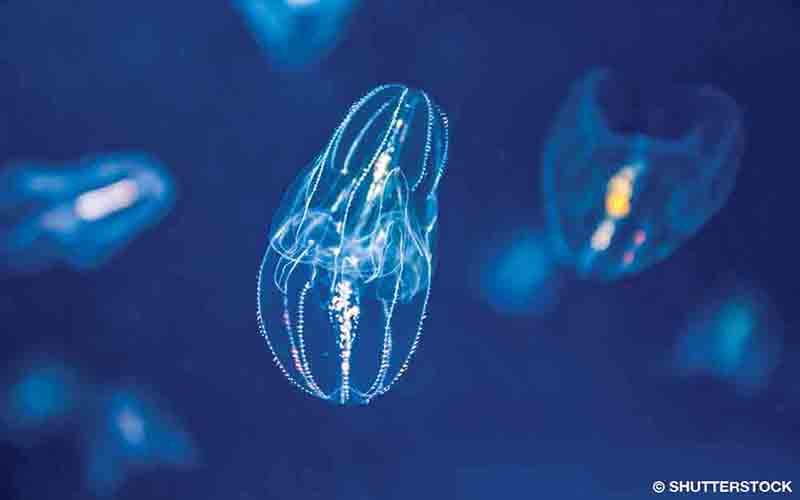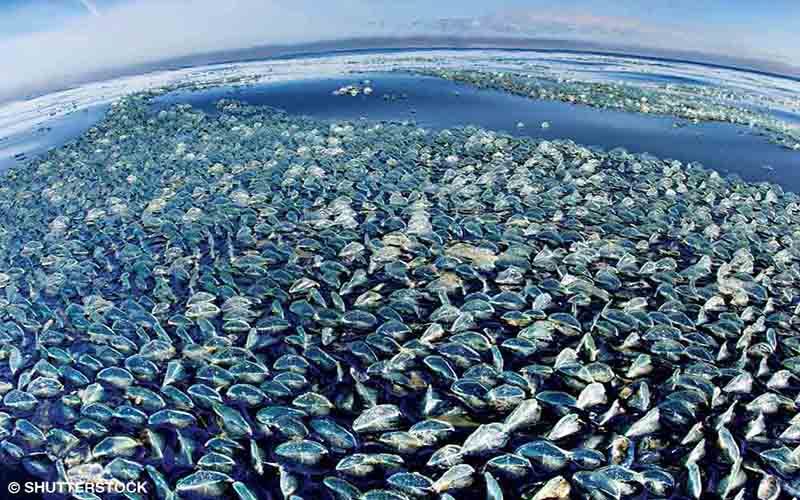Jellyfish may have painful stings, but they also have more fascinating and impressive characteristics. From their multiple-stage life cycles to their long history across the breadth and depth of the world’s seas, jellyfish may have something to tell us about the changing health of their waters.
Defining Jellyfish
There is some disagreement within the scientific community about the true definition of jellyfish. Out of the 10,000 species in the phylum Cnidaria, which also includes sea anemones and corals, what we think of as jellyfish are fewer than 4,000 species of the subphylum Medusozoa. Some scientists add the phyla Ctenophora (comb jellies) and Chordata (salps), although their true relationship is still debated.

Jellyfish get their common name from the gelatinous material, called mesoglea, that makes up most of their bodies. This substance consists primarily of water and includes muscle, structural proteins and nerve cells. Jellies also have an external epidermis containing a loose nerve network (the most basic nervous system of any multicellular animal), an internal layer of cells and a single opening to ingest food and exchange reproductive cells.
While most jellyfish measure less than an inch wide, the lion’s mane jellyfish can grow up to 8 feet wide with tentacles longer than 90 feet.
Life Cycles
Adult jellyfish in their bell-shaped stage are called medusae. Medusae spawn by releasing eggs and sperm into the open ocean; fertilized eggs then develop into planulae, or free-swimming flat larvae. Within days the planulae attach themselves to surfaces and become tentacled polyps, which can either reproduce asexually by dividing into two genetically identical polyps or transform into medusae. In some species, the polyps will split into multiple platelike segments called strobila, which will then separate into juveniles called ephyrae that then mature into medusae. A medusa will generally live for a few months, while polyps can live and reproduce asexually for years or even decades.
Not all jellyfish are faithful to this cycle, marine biologist Juli Berwald explains; some jellyfish have the capacity to revert to earlier stages, something no other known organisms can do, earning them the nickname “immortal jellyfish.” A few species can even turn a piece of a tentacle into a polyp that will then go through its normal life cycle.
Swimming Styles
Jellyfish swim by either jet propulsion or rowing propulsion. Those that swim by jet propulsion rapidly contract their bells to squirt out water and push the body forward, like letting go of an air-filled balloon.
“Jetters can’t get larger than a few centimeters,” says John Costello, biology professor at Providence College in Rhode Island. “Their muscle fibers are one cell thick, which limits the force they can exert, and it takes a lot of force to rapidly expel water.” These “jetters” represent the vast majority of jellyfish, but given their tiny size we seldom see them.
“Rowers” — which include moon jellies, lion’s mane jellyfish and sea nettles — can grow larger. To swim, rowers contract their bells to create suction thrust, which pulls them forward by lowering the pressure on the upper side of the bell and increasing it on the underside. The bell then relaxes, allowing water to flow around its margin and into the cavity, forming vortices. The energy contained in the vortices pushes the bell forward without muscle power. This passive energy recovery can account for more than a quarter of the distance a jellyfish travels.

“Jellyfish time their cycle, waiting for that added thrust before they recontract,” says Sean Colin, professor of environmental science at Roger Williams University in Bristol, Rhode Island. “Their swimming cycle is bell contraction, relaxation, expansion. The expansion is a sort of free ride.”
Passive energy recapture also reduces the energy necessary to travel any given distance by an astonishing 48 percent. “Compared with fish, flying animals, running animals, even other efficient swimming animals such as eels, these rowing jellyfish are more efficient,” Colin says.
To catch prey, jellyfish either cruise or ambush. Cruisers swim most of the time and capture prey that gets swept in as they pulse. Ambush species extend their tentacles to let prey swim into them, like spiders use their webs.
All cnidarians have stinging cells called nematocysts. Activated by touch or chemical cues, nematocysts can shoot needles in 700 nanoseconds — about the speed at which a shell fires from a cannon. The needles then discharge toxin with hydrostatic pressures up to 200 atmospheres, similar to the pressure in scuba tanks. These toxins paralyze prey, which the jellyfish then slowly digest.
Oceanic Alarm System
Dramatic headlines in recent years report massive blooms of jellyfish clogging water-intake systems at power plants, destroying fishing nets and causing swimmers to flee the water. Scientists say jellyfish populations have trended upward since 1950 in most of the world’s marine ecosystems, but whether they are increasing globally is a tricky question.

It can also be difficult to distinguish whether shifting trends are due to natural variation or climate change. As Lucas Brotz, research fellow at the University of British Columbia’s Institute for the Oceans and Fisheries, explains, research of this kind would require at least 40 years of data, and the unique life cycles of jellyfish create population variations that can make data unwieldy. Convincing evidence of increasing populations, however, does exist. “Not all jellyfish, and not everywhere,” Brotz cautions, “but we’re seeing more places with population increases than not.”
These population shifts result at least partially from human effects on coastal environments, including climate change, overfishing, pollution, coastal development and the introduction of invasive species. Thanks to a low metabolic rate, jellyfish tolerate low oxygen conditions, and warmer waters actually increase their reproduction rate. Furthermore, coastal developments provide more structures in the water for planulae to use for attachment.
The Eastern Mediterranean now sees massive blooms of invasive jellyfish every summer, Berwald says, thanks to significantly warmer waters and free rides on ships from the Indian Ocean through the Suez Canal. Namibia has also witnessed a dramatic rise in jellyfish populations after severe overfishing in the 1980s wiped out predators and led to the proliferation of two invasive species; jellyfish biomass there is now two to three times greater than that of fish.
Jellyfish blooms happen in both healthy and unhealthy ecosystems, Brotz notes, so not every bloom is a bad sign. But blooms can indicate environmental stress. “We need more data to figure out what might be happening,” he says. “Jellyfish interfering with human activities can cost tens of millions of dollars — and lives as well — so it behooves us to take a closer look, make better predictions and be prepared.”
“Jellyfish have survived acidic and anoxic waters and rearrangement of the oceans,” Berwald says. “Everything we see on Earth is a success story, but jellyfish are the oldest one.”
“Thankfully,” she adds, “scientists finally have begun giving jellyfish the attention they deserve.”
| © Alert Diver — Q2 2018 |
|---|
| © Alert Diver — Q2 2018 |